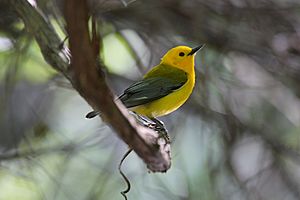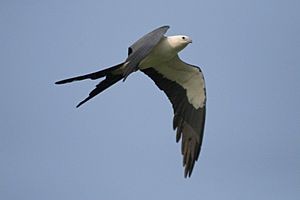Georgia's Colonial Coast Birding Trail facts for kids
The Colonial Coast Birding Trail in Georgia is a special path for anyone who loves watching birds. It's not a single walking trail, but a group of 18 amazing places. These spots are chosen because they are perfect for seeing many different kinds of birds.
Georgia is home to many bird species. More than 300 types of birds have been seen along Georgia's Colonial Birding Trail. Many of these 18 locations also have old buildings or historic sites from the 1700s and 1800s. This means you can enjoy history while you look for birds!
Contents
What Makes the Trail Special?
This trail is designed for everyone, not just expert birdwatchers. If you love birds, you can look for unique southern birds like the swallow-tailed kite or the prothonotary warbler. If you're not a bird expert, you can still explore beautiful old mansions, Civil War forts, or historic plantations.
The trail runs close to Interstate 95, making it easy for travelers to stop and explore. Georgia helps train staff at visitor centers and state parks about birdwatching basics. They even send out a newsletter called the Bird's Eye Review. This newsletter tells staff about exciting bird events, like when peregrine falcons migrate in the fall or when endangered wood storks arrive in the spring. The wood stork is even the symbol for the trail!

Why Georgia's Coast is Great for Birds
The southeastern coast of Georgia is one of the best places in the country for birdwatching. It has many different natural homes for birds, like marshes and coastal islands. Lots of birds live here all year round. Many others visit during their long migrations or spend part of the year near the sea islands.
More than 300 bird species have been seen along Georgia's coast. The state of Georgia created the Colonial Coast Birding Trail to highlight these amazing bird spots. The trail points out many "hot spots" for birds. These range from the north beach of Tybee Island to the wild areas of the undeveloped Cumberland Island National Seashore.
Beautiful Landscapes and Important Bird Areas
Along the Georgia coast, you'll find many beautiful sights. There are paths lined with grand live oak trees, shiny tidal flats full of sandpipers and terns, and wide, sweeping salt marshes where wading birds gather. Almost anywhere in this region can be good for birdwatching. But to find the very best spots, visitors with binoculars can focus on the 18 sites featured on this trail.
Most of these locations are also named Important Bird Areas. This shows how vital they are for all kinds of migrating birds that pass through. Birds like black skimmers, clapper rails, and American oystercatchers can be found in every season. In the fall, even more birds arrive, including piping plovers and many different songbird flocks.
Trail Sites and Bird Species
The Colonial Coast Birding Trail includes 18 specific locations. Each site offers unique opportunities to see different bird species. Here is a list of these sites and some of the special birds you might spot there:
| Name | Specialties |
|---|---|
| Ansley Hodges M.A.R.S.H. Project (Altamaha Wildlife Management Area) | Wood stork, swallow-tailed kite, bald eagle, king rail, painting bunting, mottled duck, wood duck, white ibis, glossy ibis |
| Crooked River State Park | Osprey, bald eagle, wood stork, painted bunting |
| Cumberland Island National Seashore | Peregrine falcon, painting bunting, red knot, black skimmer, warblers |
| Fort McAllister State Historic Park | Painted bunting, wood duck, northern harrier, bald eagle, osprey |
| Fort Morris State Historic Site | Yellow-throated warbler, marsh wren, clapper rail, painted bunting |
| Fort Pulaski National Monument | Painted bunting |
| St. Simons Island - Gould's Inlet & East Beach | American oystercatcher, black skimmer, painted bunting, bald eagle, least tern, northern gannet |
| Harris Neck National Wildlife Refuge | Wood stork, white ibis, painted bunting |
| Hofwyl-Broadfield Plantation State Historic Site | Wood stork, bald eagle, osprey, glossy ibis, painted bunting, yellow-throated warbler, sharp-tailed sparrow, northern parula |
| Jekyll Island - causeway | Osprey, bald eagle, clapper rail, northern harrier, roseate spoonbill, red knot, black-necked stilt, white ibis, wood stork |
| Jekyll Island - North End Beach | Least tern, red-throated loon, scoters, American oystercatcher, black skimmer |
| Jekyll Island - South End Beach | Black skimmer, American oystercatcher, marbled goodwit, jaegers, south polar skua, northern gannet, piping plover, glaucous gull |
| Melon Bluff Nature Preserve | Wild turkey, wood stork, clapper rail, roseate spoonbill, painted bunting |
| Okefenokee National Wildlife Refuge | Sandhill crane, red-cockaded woodpecker, prothonotary warbler, northern parula, Bachman's sparrow |
| Richmond Hill - J.F. Gregory Park | Prothonotary warbler, wood duck, barred owl |
| Savannah–Ogeechee Canal Museum & Nature Center | Prothonotary warbler, northern parula, Swainson's warbler, wood duck, Mississippi kite, swallow-tailed kite |
| Skidaway Island State Park | Osprey, painted bunting, pileated woodpecker, bald eagle |
| Tybee Island - North Beach | Purple sandpiper, piping plover, northern gannets |


